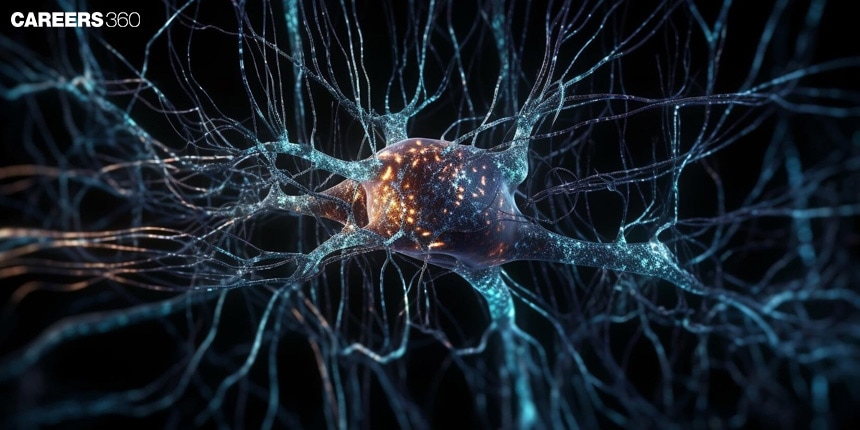Nerve Fibres: Properties And Classification: Classification And Properties
Nerve fibres are the thread-like extensions of neurons that transmit electrical impulses throughout the body. They are classified into myelinated fibres, which are covered with a protective myelin sheath for faster signal transmission, and non-myelinated fibres, which lack this sheath and conduct impulses more slowly. In this article, nerve fibres, the structure of nerve fibres, the classification of nerve fibres, and the properties of nerve fibres are discussed. Nerve Fibres is a topic of the chapter Neural Control and Coordination in Biology.
This Story also Contains
- What are Nerve Fibres?
- Structure of Nerve Fibres
- Classification of Nerve Fibres
- Properties of Nerve Fibres

What are Nerve Fibres?
Nerve fibres are vital elements of the nervous system that facilitate the transportation of electrical signals, or, in other words, nerve impulses across the body. They are essentially composed of axons which refer to the thread-like protrusions of nerve cells or, in other words, neurons. Knowledge of nerve fibre properties has to be gained or learned to the maximum extent by medical experts and scholars who are linked with medical studies to understand the neurological functions and disease diagnosis processes meticulously.
Structure of Nerve Fibres
These are some of the critical structures of the axon are :
Axoplasm: The axon's cytoplasm activates the transport of metabolic activities in the nerve
Axolemma: Membrane that covers the axon. it is essential for the structural integrity of the nerve fiber
Nodes of Ranvier: these are the intervals of myelin sheath along the axon. the nodes of Ranvier help the impulses to travel fast with saltatory conduction.
Myelin Sheath: Myelin is a lipid material that wraps around the axon and is protective.
Also Read-
- MCQ practice on the Nerve
- Neural Control And Coordination
- Control and Coordination
- Central Nervous System
Classification of Nerve Fibres
Based on the main criteria:
Classification of Nerve Fibres According to Diameter and Conduction Velocity
Groups A, B and C fibres can be classified according to their diameter, degree of myelination, conduction velocity and the type of function.
- Group A Nerve Fibres: Alpha Aα, beta Aβ, gamma Aγ, and delta Aδ are the four varieties of group A nerve fibres, which are highly myelinated. Impulses tend to travel more quickly across fibres with greater myelination and diameter.
- Group B Nerve Fibres: They are more myelinated than those in group C, but they are less myelinated than those in group A. Among these are visceral nerves like the vagus nerve.
- Group C Nerve Fibres: These unmyelinated nerve fibres often have a lower conduction velocity and a smaller diameter.
Classification According to Function
The nerve fibres are classified as either afferent or efferent based on their functional relationship to the central nervous system. Let's examine each one separately.
- Afferent Nerve fibres: These peripheral nerve fibres are known as afferent nerve fibres because they bring impulses from various body receptors to the central nervous system. The nature of these fibres is pseudounipolar.
- Efferent Nerve Fibres: Efferent nerve fibres are the fibres that transport nerve impulses from the central nervous system to various effector organs, including muscles and glands. They are multipolar in nature morphologically.
Classification based on the Presence of Myelin Sheath
The nervous system contains both myelinated and unmyelinated nerve fibres. The proportional content of the two types of nerve fibres varies.
- Myelinated Nerve Fibres: A layer of insulating material known as the myelin sheath surrounds myelinated nerve fibres. Schwann cells form the myelin sheath in the peripheral nervous system, while oligodendrocytes form the myelin sheath in the central nervous system.
- Nonmyelinated Nerve Fibres: Schwann cells' cytoplasm covers nonmyelinated nerve fibres, but in these situations, no myelin is secreted. The autonomic nerve system frequently contains them.
Properties of Nerve Fibres
The properties of nerve fibres have the following very basic inferences:
Conduction Velocity
The fibre diameter and the extent of myelination are strong determinants of conduction velocity. A fibres conduct faster than the slower B and C fibres.
Refractory Periods
The period during which a nerve fibre is not capable of conducting a second impulse after transmission of the first impulse. Ensures orderly conduction of nerve signals and prohibits overlap of impulses.
All or None Response
Either all or none of the impulses are translated by a nerve fibre. An action potential will be produced if a stimulus is applied up to a threshold level; however, the action potential will not be impacted by increasing the stimulus's power.
Summation
An action potential cannot be produced by applying a stimulus that is below the threshold. However, an action potential is produced when several sub-threshold stimuli are presented quickly one after the other.
Also Read-
Frequently Asked Questions (FAQs)
The myelin sheath insulates the nerve fibres from each other, increasing the speed of transmission of nerve impulses. In addition, it helps in the maintenance of the integrity of the nerve fibre.
The conducting rate or velocity depends on the size of a nerve fibre and also its myelination. Nerve fibres of larger diameter and myelinated fibres conduct faster than small unmyelinated fibres.
Nerve fibres are the long, slender projections of nerve cells that carry electrical signals throughout the body. Carry the information from the periphery to the brain and spinal cord and relay the orders from the brain and spinal cord to the glands and muscles.
There are three kinds of nerve fibres: A, B, and C. The A-fiber represents large myelinated fibres; B and C are less myelinated and hence are smaller in calibre; C-fibers are slowest in conducting impulses.